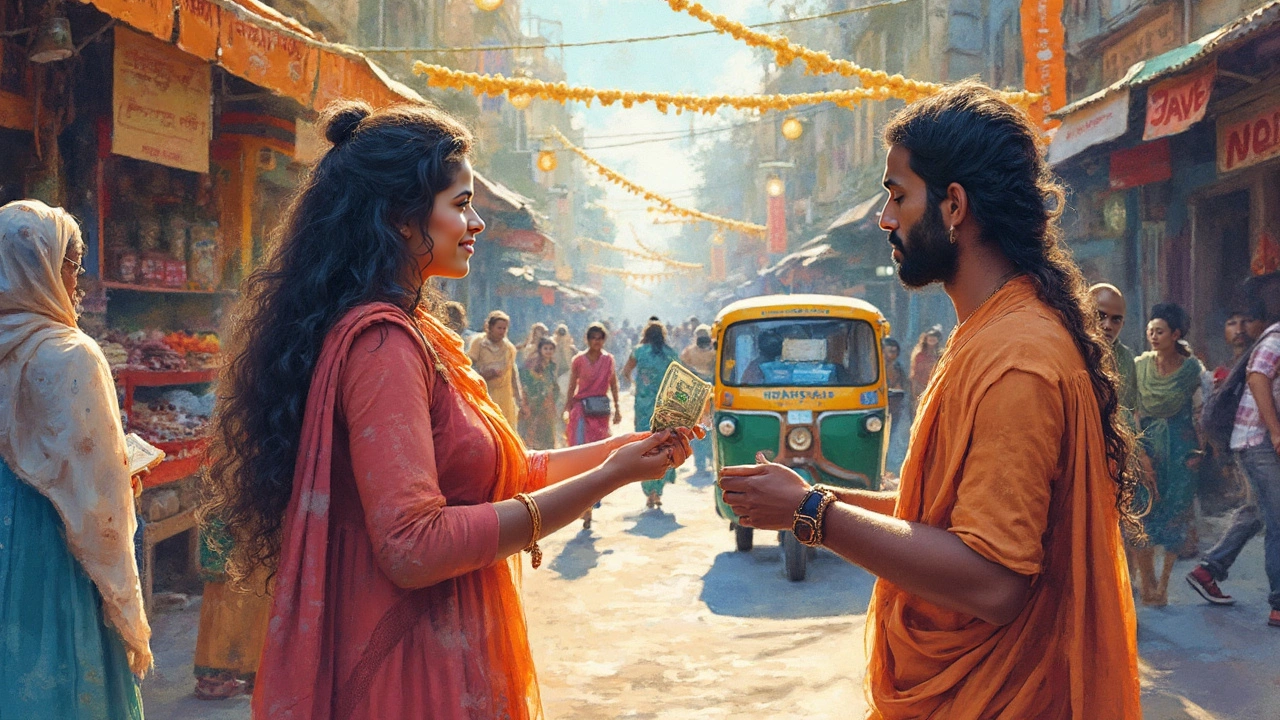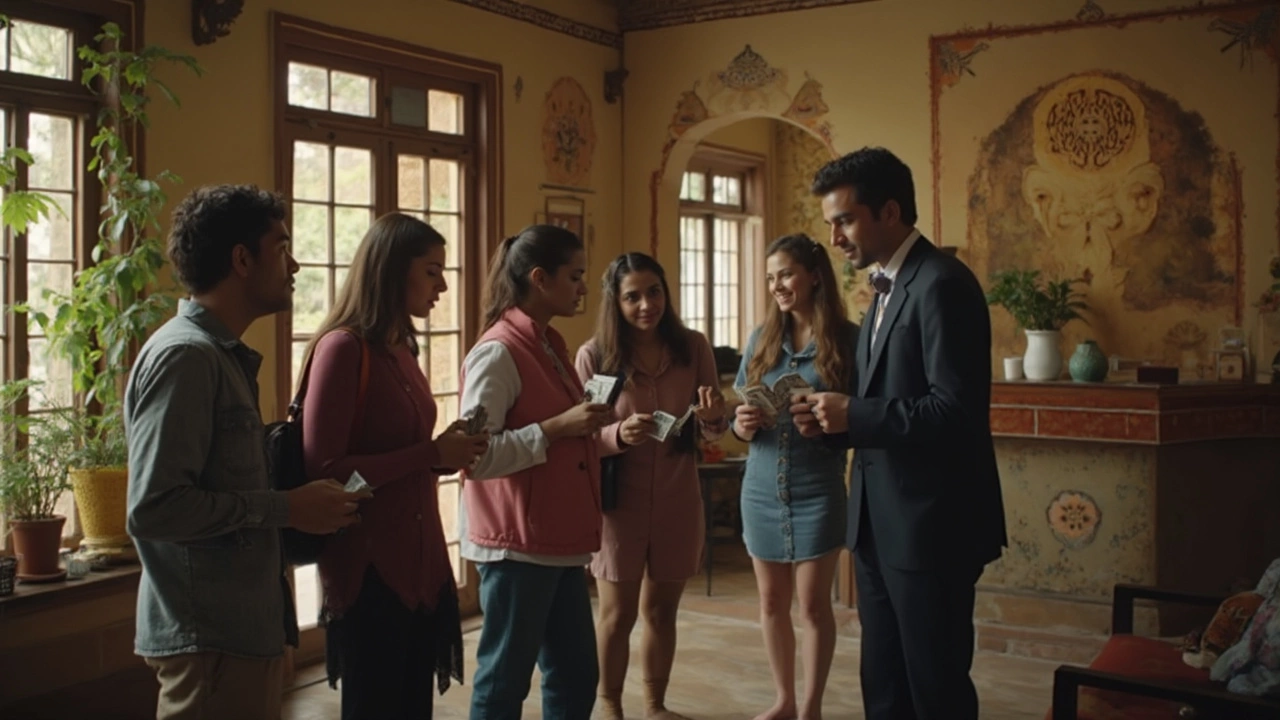Can You Use US Dollars in India? Practical Travel Money Guide

- Jun, 23 2025
- 0 Comments
- Aaron Blackwood
Not sure if you can whip out US dollars in India and pay for street chai or a hostel bed? You’re definitely not the only one. A lot of travelers arrive thinking dollars are king everywhere. But in India, the official currency is the Indian rupee (INR) and pretty much all everyday shops, local markets, and smaller hotels don’t accept any foreign cash, even crisp $100 bills. You won’t be buying a train ticket or samosas with USD.
The only exceptions are maybe a few five-star hotels or high-end tourist shops in major cities, and even then the rates won’t be in your favor. Locals definitely don’t use dollars day-to-day, and you could even get odd stares for trying. For most of your trip, you’ll need rupees for everything from tuk-tuks to bottled water.
- Where (And If) USD is Accepted
- The Right Way to Exchange Money
- Best Options for Budget Travelers
- Smart Safety and Money Tips
Where (And If) USD is Accepted
If you’re holding onto US dollars hoping to pay your way around India, you’re going to hit some walls fast. In most places—especially local markets, train stations, and restaurants—your dollars just won’t work. The US dollars in India concept is more myth than reality for daily spending.
So where, if anywhere, can you actually use USD? Here’s the real scoop:
- Big-name hotels: Fancy international hotels (like Marriott, Taj, and Hyatt in big cities) might let you pay your room bill in dollars or ask if you want your card charged in USD. But the exchange rate? Usually bad.
- Some tourist agencies: Major tour operators selling packages specifically for international tourists may accept USD for big-ticket services like airport transfers, but again, expect a poor conversion.
- Airport duty-free shops: A few duty-free stores at major airports sell high-end items (think perfumes and chocolates) for USD, but only before you exit customs/immigration. Once you’re ‘in’ India, it’s all rupees.
Everyday places like taxis, street stalls, local supermarkets—even most mid-range hotels—just won’t take US cash. India's banking system and currency laws are strict about rupee-only transactions for locals, and you’ll sometimes see signs reminding tourists of this rule.
To make things a bit more visual, here’s a quick breakdown of where USD will and won't get you far:
| Location | USD Accepted? | Notes |
|---|---|---|
| Big International Hotels (Delhi, Mumbai, Goa) | Sometimes | Usually bad exchange rates; check in advance |
| Airport Duty-Free Shops | Yes (Arrival/Departure Only) | For select shops before customs; not in domestic area |
| Taxis, Local Markets, Restaurants | No | Rupees only, no exceptions |
| Tour Operators catering to foreigners | Sometimes | Mostly for pre-arrangement only, higher cost |
| Regular Shops & Attractions | No | All need rupees |
Bottom line: treat your US dollars as backup—good for emergency exchange, but not for direct spending anywhere regular.
The Right Way to Exchange Money
If you’re heading to India with US dollars, swapping your cash for rupees is step one for every traveler. You’ll find money exchange counters at major airports like Delhi, Mumbai, and Bengaluru. The airport ones are easy and legit, but honestly—rates there are rarely the best. Think of them as your backup plan, like if you land in the middle of the night or need just enough rupees to grab a taxi into town.
Once you’re in the city, skip the hotel desk and look for authorized money changers or banks. These usually offer better rates and don’t try to tack on hidden fees. In fact, the Reserve Bank of India (RBI) has a strict policy: only authorized dealers—like banks and licensed counters—should touch foreign cash. Some popular chains like Thomas Cook India, Muthoot Forex, and Cox & Kings have branches in tourist areas. Street side exchangers might tempt you but can be risky for fake notes or short-changing—don’t risk it for a few extra rupees.
ATM withdrawals are also a solid move. Most cities, towns, and even airports have ATM machines that work with international cards (Visa, Mastercard, sometimes Cirrus or Plus). Using an ATM usually gets you a rate close to the official market rate. Just keep in mind: Indian ATMs often charge around 200 INR per withdrawal, and your home bank might also slap on a foreign transaction fee. So, pull out enough for a few days at a time if you want to keep costs down.
Here’s a quick comparison of common ways to get rupees in India:
| Method | Exchange Rate | Typical Fees | Convenience |
|---|---|---|---|
| Airport Counter | Poor to Fair | 0%–2% fee | High |
| Bank | Good | 0%–1% fee | Medium |
| Authorized Money Changer | Good to Very Good | Small commission | High (in tourist areas) |
| ATM Withdrawal | Best (closest to market) | 200 INR per withdrawal + home bank fees | Very High |
Always count your rupees, check for torn or damaged notes (some places won’t take them), and hang onto your exchange receipt—if you have leftover rupees at the end of your trip, you’ll need that slip to swap them back into dollars at the airport before you leave.

Best Options for Budget Travelers
Trying to stretch your money in India? Here’s how to avoid losing cash on fees or bad exchange rates. The first thing to know: always convert your dollars to Indian rupees as soon as you arrive, but be smart about where and how you do it.
The absolute worst place to exchange money is at airports. They’re convenient but always offer the lowest rates and highest fees. Instead, use official money changers in cities or get cash directly from bank ATMs. Most ATMs in India accept international cards (Visa and Mastercard have the least trouble), and the rates are usually close to market rates.
- Let your bank know you’re coming to India. If your card gets blocked here, getting it unblocked is a nightmare.
- Choose ATMs attached to major banks like SBI, HDFC, or ICICI. They’re easier to find in cities and have clearer English menus.
- Most Indian ATMs have a withdrawal fee, usually around ₹200 per transaction (that’s about $2.50). Many US banks also charge a foreign withdrawal fee. If you take out larger amounts each time, you’ll pay fewer fees overall.
- Watch out for dynamic currency conversion at the ATM. Always choose to be charged in rupees, never in dollars. The "in dollars" option can cost you up to 7% extra.
For the best deals, some veteran travelers bring a few hundred dollars in crisp bills as backup, but use ATMs for most spending. Money changers in tourist areas can work for emergencies, but compare rates before you hand over cash. There’s no harm in asking for a receipt if you’re worried about scams.
Here’s a quick breakdown of the three top ways to get rupees, plus typical associated costs:
| Method | Average Fee | Best For |
|---|---|---|
| Bank ATM Withdrawal | ₹150-200 + your home bank’s fee | Everyday expenses, cash on the go |
| Currency Exchange (City Kiosk) | 1-3% commission, watch out for rates | Backup cash, emergencies |
| Airport Exchange Counter | 3-7% markup, hidden fees | Last resort, late-night arrival |
If you want to avoid cash altogether, digital wallets like Paytm and Google Pay have exploded in India, but they’re only available to those with an Indian bank account. Don’t count on using Apple Pay or US-based apps for US dollars in India—it just doesn’t work yet. Stick to cash and your bank card, and you’ll sidestep headaches.
Smart Safety and Money Tips
Carrying around cash in India means you’ve got to play it smart. First thing: always split your money. Don’t keep all your rupees, cards, and backup cash in one place—stash some in your main bag, a bit in a day pack, and maybe a little emergency fund in a hidden travel pouch. If you use a belt bag or pouch, don’t make a big deal showing it on the street.
When it comes to ATMs, India has a lot of them, even in smaller cities, but stick to machines attached to actual banks and avoid ATMs on random street corners. Frauds like skimming devices are rare, but they’ve been reported. Always shield your PIN and double-check for any weird attachments on the machine.
Small bills are your best friend. Getting 2,000-rupee notes from the ATM seems cool until a tuk-tuk driver or a tiny chai stall can’t break it. Get change as soon as you can. Most local vendors don’t have card machines, and UPI and Paytm (local digital wallets) tend to work only with Indian bank accounts, so cash is king for travelers. Never rely on one debit or credit card: have a backup stored separately. Some cards, like Wise and Revolut, have super low foreign ATM fees, which is a big bonus.
Watch out for counterfeit rupee notes—check for the see-through security thread, watermarks, and rough texture of real notes. Unlike dollars, rupees get handled a ton in daily life, so beat-up bills are normal, but double-check big notes (₹500, ₹2000). If a vendor gives you damaged money, ask for a replacement on the spot.
| Money Safety Tip | Why It Matters |
|---|---|
| Split your cash | If you get pickpocketed, you won’t lose everything |
| Stick to bank ATMs | Reduces risk of skimming and higher fees |
| Carry small bills | Vendors rarely have change for large notes |
| Watch out for fakes | Counterfeit notes still circulate sometimes, cost you money |
| Use backup cards | Main cards can get blocked or eaten by ATMs |
And here’s a wildcard—don’t flash wads of US dollars in India thinking you’ll get special deals. You’ll get unwanted attention, and no one is impressed. Keep it simple, blend in, and treat your cash like you would on a busy subway back home.